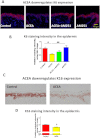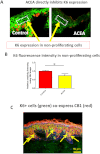A novel control of human keratin expression: cannabinoid receptor 1-mediated signaling down-regulates the expression of keratins K6 and K16 in human keratinocytes in vitro and in situ
- PMID: 23638377
- PMCID: PMC3628749
- DOI: 10.7717/peerj.40
A novel control of human keratin expression: cannabinoid receptor 1-mediated signaling down-regulates the expression of keratins K6 and K16 in human keratinocytes in vitro and in situ
Abstract
Cannabinoid receptors (CB) are expressed throughout human skin epithelium. CB1 activation inhibits human hair growth and decreases proliferation of epidermal keratinocytes. Since psoriasis is a chronic hyperproliferative, inflammatory skin disease, it is conceivable that the therapeutic modulation of CB signaling, which can inhibit both proliferation and inflammation, could win a place in future psoriasis management. Given that psoriasis is characterized by up-regulation of keratins K6 and K16, we have investigated whether CB1 stimulation modulates their expression in human epidermis. Treatment of organ-cultured human skin with the CB1-specific agonist, arachidonoyl-chloro-ethanolamide (ACEA), decreased K6 and K16 staining intensity in situ. At the gene and protein levels, ACEA also decreased K6 expression of cultured HaCaT keratinocytes, which show some similarities to psoriatic keratinocytes. These effects were partly antagonized by the CB1-specific antagonist, AM251. While CB1-mediated signaling also significantly inhibited human epidermal keratinocyte proliferation in situ, as shown by K6/Ki-67-double immunofluorescence, the inhibitory effect of ACEA on K6 expression in situ was independent of its anti-proliferative effect. Given recent appreciation of the role of K6 as a functionally important protein that regulates epithelial wound healing in mice, it is conceivable that the novel CB1-mediated regulation of keratin 6/16 revealed here also is relevant to wound healing. Taken together, our results suggest that cannabinoids and their receptors constitute a novel, clinically relevant control element of human K6 and K16 expression.
Keywords: Cannabinoid; Keratin; Psoriasis; Wound healing.
Figures




Similar articles
-
Keratins (K16 and K17) as markers of keratinocyte hyperproliferation in psoriasis in vivo and in vitro.Br J Dermatol. 1995 Oct;133(4):501-11. doi: 10.1111/j.1365-2133.1995.tb02696.x. Br J Dermatol. 1995. PMID: 7577575
-
Nrf2 Promotes Keratinocyte Proliferation in Psoriasis through Up-Regulation of Keratin 6, Keratin 16, and Keratin 17.J Invest Dermatol. 2017 Oct;137(10):2168-2176. doi: 10.1016/j.jid.2017.05.015. Epub 2017 May 30. J Invest Dermatol. 2017. PMID: 28576737
-
Transient synthesis of K6 and K16 keratins in regenerating rabbit corneal epithelium: keratin markers for an alternative pathway of keratinocyte differentiation.Differentiation. 1989 Dec;42(2):103-10. doi: 10.1111/j.1432-0436.1989.tb00611.x. Differentiation. 1989. PMID: 2483836
-
Keratins and the keratinocyte activation cycle.J Invest Dermatol. 2001 May;116(5):633-40. doi: 10.1046/j.1523-1747.2001.01327.x. J Invest Dermatol. 2001. PMID: 11348449 Review.
-
Overexpression of human keratin 16 produces a distinct skin phenotype in transgenic mouse skin.Biochem Cell Biol. 1995 Sep-Oct;73(9-10):611-8. doi: 10.1139/o95-067. Biochem Cell Biol. 1995. PMID: 8714680 Review.
Cited by
-
The effect of cannabinoids on wound healing: A review.Health Sci Rep. 2024 Feb 25;7(2):e1908. doi: 10.1002/hsr2.1908. eCollection 2024 Feb. Health Sci Rep. 2024. PMID: 38410495 Free PMC article. Review.
-
TRP channel cannabinoid receptors in skin sensation, homeostasis, and inflammation.ACS Chem Neurosci. 2014 Nov 19;5(11):1107-16. doi: 10.1021/cn5000919. Epub 2014 Jun 17. ACS Chem Neurosci. 2014. PMID: 24915599 Free PMC article. Review.
-
Activity-guided purification identifies lupeol, a pentacyclic triterpene, as a therapeutic agent multiple pathogenic factors of acne.J Invest Dermatol. 2015 Jun;135(6):1491-1500. doi: 10.1038/jid.2015.29. Epub 2015 Feb 3. J Invest Dermatol. 2015. PMID: 25647437
-
Cannabinoid Signaling in the Skin: Therapeutic Potential of the "C(ut)annabinoid" System.Molecules. 2019 Mar 6;24(5):918. doi: 10.3390/molecules24050918. Molecules. 2019. PMID: 30845666 Free PMC article. Review.
-
Specific Activation of CB2R Ameliorates Psoriasis-Like Skin Lesions by Inhibiting Inflammation and Oxidative Stress.Inflammation. 2023 Aug;46(4):1255-1271. doi: 10.1007/s10753-023-01805-6. Epub 2023 Mar 31. Inflammation. 2023. PMID: 37000322
References
-
- Bodo E, Kany B, Gaspar E, Knuver J, Kromminga A, Ramot Y, Biro T, Tiede S, van Beek N, Poeggeler B, Meyer KC, Wenzel BE, Paus R. Thyroid-stimulating hormone, a novel, locally produced modulator of human epidermal functions, is regulated by thyrotropin-releasing hormone and thyroid hormones. Endocrinology. 2010;151:1633–1642. doi: 10.1210/en.2009-0306. - DOI - PubMed
LinkOut - more resources
Full Text Sources
Other Literature Sources
Research Materials
Miscellaneous

